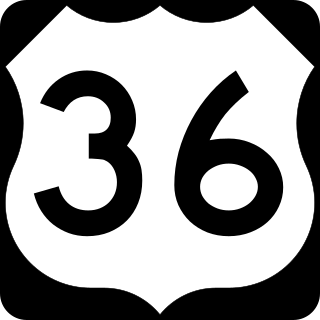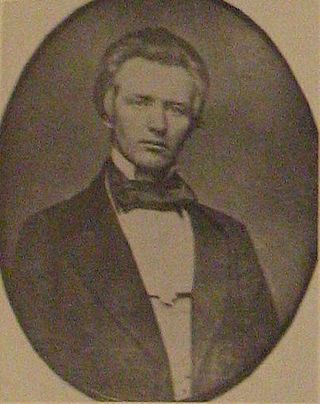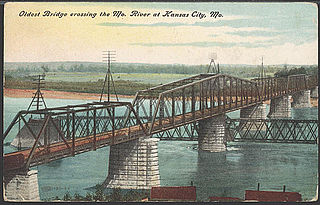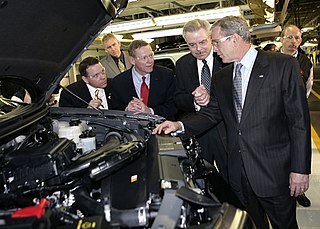
Hannibal is a city along the Mississippi River in Marion and Ralls counties in the U.S. state of Missouri. According to the 2020 U.S. Census, the population was 17,312, making it the largest city in Marion County. The bulk of the city is in Marion County, with a tiny sliver in the south extending into Ralls County.

BNSF Railway is the largest freight railroad in the United States. One of six North American Class I railroads, BNSF has 36,000 employees, 33,400 miles (53,800 km) of track in 28 states, and over 8,000 locomotives. It has three transcontinental routes that provide rail connections between the western and eastern United States. BNSF trains traveled over 169 million miles in 2010, more than any other North American railroad.

The Southwest Chief is a long-distance passenger train operated by Amtrak on a 2,265-mile (3,645 km) route between Chicago and Los Angeles through the Midwest and Southwest via Kansas City, Albuquerque, and Flagstaff mostly on the BNSF's Southern Transcon, but branches off between Albuquerque and Kansas City via the Topeka, La Junta, Raton, and Glorieta Subdivision. Amtrak bills the route as one of its most scenic, with views of the Painted Desert and the Red Cliffs of Sedona, as well as the plains of Illinois, Missouri, Kansas, and Colorado.

The Chicago, Burlington and Quincy Railroad was a railroad that operated in the Midwestern United States. Commonly referred to as the Burlington Route, the Burlington, CB&Q, or as the Q, it operated extensive trackage in the states of Colorado, Illinois, Iowa, Missouri, Nebraska, Wisconsin, Wyoming, and also in Texas through subsidiaries Colorado and Southern Railway, Fort Worth and Denver Railway, and Burlington-Rock Island Railroad. Its primary connections included Chicago, Minneapolis–Saint Paul, St. Louis, Kansas City, and Denver. Because of this extensive trackage in the midwest and mountain states, the railroad used the advertising slogans "Everywhere West", "Way of the Zephyrs", and "The Way West".

U.S. Route 36 (US 36) is an east–west United States Numbered Highway that travels approximately 1,414 miles (2,276 km) from Rocky Mountain National Park, Colorado to Uhrichsville, Ohio. The highway's western terminus is at Deer Ridge Junction, an intersection in Rocky Mountain National Park, Colorado, where it meets US 34. Its eastern terminus is at US 250 in Uhrichsville, Ohio.

Robert Marcellus Stewart was the 14th Governor of Missouri from 1857 to 1861, during the critical years just prior to the American Civil War.
Terminal railway post offices were sorting facilities which were established by the Railway Mail Service to speed the distribution of parcel post. These offices were usually located in or near railroad stations in major cities or junction points. Terminal railway post offices operated generally from 1913-1914 into the mid-1960s, before their function was absorbed by post office sectional centers.

The Quincy Rail Bridge is a truss bridge that carries a rail line across the Mississippi River between West Quincy, Missouri, and Quincy, Illinois, USA. It was originally constructed in 1868 for the Chicago, Burlington and Quincy Railroad, a predecessor of BNSF Railway.

The Kansas City Terminal Railway is a Class III terminal railroad that serves as a joint operation of the trunk railroads that serve the Kansas City metropolitan area, the United States' second largest rail hub after Chicago. It is operated by the Kaw River Railroad.

The Kansas City and Cameron Railroad was the subsidiary of the Hannibal and St. Joseph Railroad which built the first bridge across the Missouri River at the Hannibal Bridge.

The Platte Bridge Railroad Tragedy was a bushwhacker attack on the Hannibal and St. Joseph Railroad during the American Civil War on September 3, 1861, in which the train derailed on a bridge over the Platte River east of St. Joseph, Missouri, killing between 17 and 20 and injuring 100. The bridge crosses the river in Buchanan County, between Marion Township on the east, and Washington Township on the west.

Missouri's 6th congressional district takes in a large swath of land in northern Missouri, stretching across nearly the entire width of the state from Kansas to Illinois. Its largest voting population is centered in the northern portion of the Kansas City metropolitan area and the town of St. Joseph. The district includes much of Kansas City north of the Missouri River.

Crossing the Kansas River in Kansas City, Kansas, United States, the Highline Bridge is rare example of a double-tracked, double-deck railroad bridge designed for carrying railroad traffic on both levels. The bridge is owned and operated by the Kansas City Terminal Railway (KCTR) and provides access between the extensive rail yards on both sides of the river in the Argentine and Armourdale neighborhoods in Kansas City, Kansas, and other rail yards in Kansas City, Missouri.

U.S. Route 36 in the state of Missouri is an expressway with many freeway sections, connecting Kansas to Illinois. From Cameron to the Illinois state line, it forms part of the principal route between Kansas City and Chicago, known as the Chicago–Kansas City Expressway.

The Chicago–Kansas City Expressway is a highway that runs between Chicago, Illinois, and Kansas City, Missouri. The road is known as Route 110 in Missouri and Illinois Route 110 (IL 110) in Illinois. IL 110 was created through legislation on May 27, 2010, as the designated route for the Illinois portion of the Chicago–Kansas City Expressway.

The Wabash Railroad was a Class I railroad that operated in the mid-central United States. It served a large area, including track in the states of Ohio, Indiana, Illinois, Iowa, Michigan, and Missouri and the province of Ontario. Its primary connections included Chicago, Illinois; Kansas City, Missouri; Detroit, Michigan; Buffalo, New York; St. Louis, Missouri; and Toledo, Ohio.
The Chillicothe Subdivision or "Chillicothe Sub" is a railway line running about 229 miles (369 km) from Chicago, Illinois to Fort Madison, Iowa in the United States of America. It is operated by BNSF Railway as part of their Southern Transcon route from Chicago to Los Angeles. The Chillicothe Subdivision is a high volume route connecting three principal yards in Chicago in the east and the Marceline Subdivision in the west which continues to Kansas City.

The North Missouri Railroad was a railway company that operated in the states of Missouri and Iowa in the mid-19th century. Incorporated in 1851, at its peak it owned or leased nearly 500 miles (800 km) of track. It was reorganized as the St. Louis, Kansas City and Northern Railway, a forerunner of the Wabash Railroad, in 1872.

The Argentine Yard is a classification yard of the BNSF Railway in Kansas City, Kansas. With 60 directional tracks and an area of over 3 km2, it is the largest classification yard in the BNSF network. It is located between the Kansas River to the north and the Argentine district of Kansas City (Kansas) to the south, about ten kilometers west of downtown Kansas City, Missouri.


















